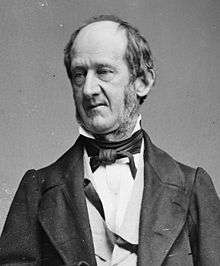Edward Stanly

Edward W. Stanly (January 10, 1810 – July 12, 1872) was a North Carolina politician and orator who represented the southeastern portion of the State in the U.S. House for five terms. In 1857, Stanly ran for Governor of California, but lost to John B. Weller. Politicians of the mid-nineteenth century remarked that Stanly bore a strong physical resemblance to William H. Seward, though this resemblance lessened over time.
Biography
Stanly was born in New Bern, North Carolina, on January 10, 1810. He was a son of U.S. Rep. John Stanly of New Bern and a cousin of U.S. Senator George Edmund Badger. Stanly attended New Bern Academy and graduated from the American Literary, Scientific and Military Academy, Norwich University in 1829. He then studied law and was admitted to the bar in 1832. He settled in Beaufort County and began to practice law.
Four years later, he successfully ran for a seat in the United States House of Representatives on the Whig ticket. He served in the Twenty-fifth, Twenty-sixth and Twenty-seventh congresses from March 4, 1837 to March 3, 1843. Stanly earned his reputation as North Carolina's greatest orator of his generation during his first term in Congress. Throughout his service in Congress, Stanly was a leader of the Southerners who emphasized the Union over states' rights. He won the nickname the 'Conqueror' during his re-election campaign of 1839.
After an unsuccessful bid for re-election in 1843 due to unfavorable redistricting, Stanly returned to North Carolina, where he served as a member of the House of Commons from 1844 to 1846 and again in 1848. He was speaker of the State House from 1844 to 1846, and his impartial presiding was hailed by Commoners of both parties as returning dignity to the chamber in the place of the former political rancor. Stanly served briefly as attorney general of North Carolina in 1847-1848.
In 1849, Stanly was again elected to the U.S. House, serving two terms from March 4, 1849 to March 3, 1853. He declined to run for a sixth term in the elections of 1853 and instead moved to California and practiced law in San Francisco. He was the Republican Party’s unsuccessful candidate for governor in 1857.
Abraham Lincoln appointed Stanly military governor of eastern North Carolina with the rank of brigadier general on May 26, 1862. Stanly resigned this office less than a year later on March 2, 1863, in a dispute with President Lincoln over the Emancipation Proclamation.
He returned to California and resumed his law practice. He died in San Francisco on July 12, 1872. He is buried in the Stanly family plot at Mountain View Cemetery in Oakland, California.
Stanly had a very colorful nephew who fought on the Confederate side during the Civil War, Brigadier General Lewis Armistead. Armistead led the Boys in Grey at Pickett’s Charge during the Battle of Gettysburg. Stanly and Armistead were born in the same house in New Bern, North Carolina. The home stands today, a pilgrimage stop for both the Blue and the Grey.
Sources consulted
- United States Congress. "Edward Stanly (id: S000799)". Biographical Directory of the United States Congress.
- NCpedia
Further reading
- Norman D. Brown, "Edward Stanly: First Republican Candidate for Governor of California," California Historical Society Quarterly, vol. 47, no. 3 (Sept. 1968), pp. 251–272. In JSTOR
- Norman D. Brown, Edward Stanly: Whiggery's Tarheel 'Conqueror.' Tuscaloosa, AL: University of Alabama Press, 1974.
External links
| United States House of Representatives | ||
|---|---|---|
| Preceded by Ebenezer Pettigrew |
Member of the U.S. House of Representatives from North Carolina's 3rd congressional district 1837–1843 |
Succeeded by David S. Reid |
| Preceded by Richard S. Donnell |
Member of the U.S. House of Representatives from North Carolina's 8th congressional district 1849–1853 |
Succeeded by Thomas L. Clingman |
| Legal offices | ||
| Preceded by Spier Whitaker |
Attorney General of North Carolina 1848–1851 |
Succeeded by Bartholomew F. Moore |
